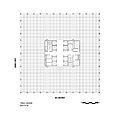140 William Street, Melbourne
- Architectural – 140 William Street is one of the most noteworthy building designs by the Melbourne firm Yuncken Freeman.
- Technological – Its innovative structural application of steel and concrete, leading to open floor plates that are now a standard feature of high rise office buildings.
- Historical – The building signifies changes in Melbourne's CBD as it transformed into a major corporate centre.
History, Key influences and design approach

BHP acquired a site at 498-502 Bourke Street in 1948 for £47,250 and earmarked it for demolition to construct a 12 storey office tower for its new headquarters. The company acquired the Menzies Hotel in 1964 and earmarked its demolition for an even taller tower. Demolition by Whelan the Wrecker proceeded in 1969. The Menzies was the city's first luxury hotel and, at the time of its demolition, remained second only to the Hotel Windsor in status as a grand Victorian hotel. Its demolition had a cultural impact and was seen as a major event in the modernisation of Melbourne. The event was painted by artist Ernest Marcuse and is part of the City of Melbourne Art and Heritage Collection.
BHP House was designed in a 'Modern Style' and construction commenced in 1970. The design was promoting the use of steel in Australian construction and sought to establish new national height standards for a steel-framed structure. Consisting of three dominant materials - steel, concrete and glass - BHP House was the tallest building in the city upon completion. The building's expressed gridded structure was a clear break from the sheer curtain walls of the 1950s and 1960s, and like the pioneering skyscrapers of Mies van der Rohe, it was designed as a three dimensional sculptural monument, detached from the surrounding cityscape. In the architectural field, BHP House is regarded as one of the most notable projects by Yuncken Freeman Architects due to cutting edge techniques for an office building such as flush glazing, minimalist interiors and expressed structural bracing.
Yuncken Freeman carried out a series of experiments for the design proposals of BHP House in the construction processes of their own offices in 1970, located at 411-415 King Street, Melbourne. Under the advice of Fazlur Khan, a structural engineer from Skidmore, Owings & Merrill, the design revolves around four basic components in order to reinvent the tower as a 'cantilever' and achieve the properties of a 'giant stiff structural tube'. The four components consist of a steel-framed flooring system, a steel-framed central core, a steel and glass façade, and steel trusses that connect the central core to the façade. Innovative techniques were employed to lay the foundations of the building – a concrete raft which was poured in a single continuous action. The weight of the floor structure was reduced by using open-web steel beams and a lightweight layer of concrete. Along with cap and belt trusses, this flooring system performed a stiffening effect and allowed structural loads to be transferred down through the central steel-framed core and the outer steel-framed façade, eradicating the need for internal columns and providing flexibility for internal spaces. The design of the building was also notable for the 'total energy system' which allowed electrical generation using BHP natural gas. BHP House set the standard for many subsequent office buildings and led to the change of Melbourne Town Planning Codes which were altered to cater for increased building heights and floor areas. When completed, it was the second tallest building in Australia behind Australia Square.
-
Building plaza and entrance from William Street
-
Building façade from corner
-
Typical floor plan
-
William Street elevation
Awards
- National Award for Enduring Architecture, 2005
- Maggie Edmond Enduring Architecture Award, 2005
- Bronze Medal, 1975 (Victoria Chapter AIA)
- Award of Merit, 1973 (Victoria Chapter AIA)
References
- ^ "140 William Street (Formerly BHP House) - Irwinconsult". Archived from the original on 17 May 2018. Retrieved 17 May 2018.
- ^ "www.onmydoorstep.com.au". Archived from the original on 18 May 2015. Retrieved 14 May 2015.
- ^ urban.melbourne
- ^ vhd.heritagecouncil.vic.gov.au
- ^ "NEW CITY BUILDING WILL CHANGE MELBOURNE SKYLINE". The Herald. No. 22, 274. Victoria, Australia. 11 October 1948. p. 4. Retrieved 13 February 2024 – via National Library of Australia.
- ^ Whelan the Wrecker notes - Robyn Annear
- ^ City of Melbourne Art and Heritage Collection - Menzies Hotel demolition
- ^ Victorian Heritage Register - BHP House
- ^ "www.architecture.com.au" (PDF). Archived from the original (PDF) on 18 March 2015. Retrieved 14 May 2015.
- ^ BHP to build Melbourne skyscraper Canberra Times 22 April 1969 page 9
External links
- urban.melbourne
- vhd.heritagecouncil.vic.gov.au
- www.architecture.com.au Archived 18 March 2015 at the Wayback Machine




